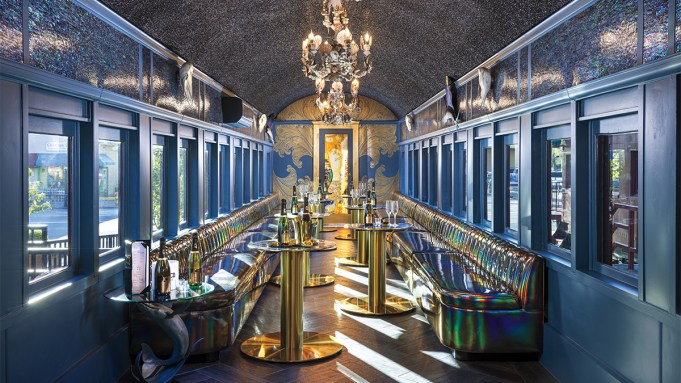Established in the late 19th century as the “Saratoga of California,” Calistoga has long lived up to its reputation as a quaint (if slightly dated) spa town surrounded by a great place to grow grapes. As a wine destination, the northernmost town in Napa Valley is usually overshadowed by its down-valley neighbors; while many wine lovers spend their nights here in high-end properties run by Auberge, Four Seasons, and Rosewood, the typical Calistoga visitor is looking forward to a mud bath instead of a fantastic bottle or an unforgettable culinary experience.
That all changes with the opening of Calistoga Depot, an extravagant dining-and-drinking complex in the town’s historic 1868 train station renovated by French vigneron Jean-Charles Boisset and opened in partnership with Michael Madden. The terminal’s original entrance now hosts Boisset’s Depot Provisions, offering gourmet goods and prepared food as well as a phenomenal wine selection that highlights Calistoga and Napa Valley favorites, plus plant-based Nova Terra Kitchen & Creamery. The Great Hall, with its soaring ceiling and enormous bar fronted by miners’ shovels and topped with a pair of giant copper stills, is home to Calistoga Depot Distillery 1868, the spot to sample Boisset’s full line of proprietary small-batch spirits, from Fame & Misfortune straight rye whiskey to Prosperous & Penniless barrel-aged gin.
The copper-clad Distillery Room offers several tasting experiences.
Scott Chebegia
On the original platform, a series of elegantly refurbished rail cars evokes the golden age of train travel. Each has been playfully converted into a distinct destination, including Earth & Sky Chocolates, upscale Mexican eatery and tequila bar Casa Obsidiana, the First Millionaire’s Saloon (named after Sam Brannan, the founder of Calistoga and California’s first millionaire), and the JCB Parlor Car, offering Champagne, oysters, and caviar.

The exterior of the JCB Parlor Car.
Scott Chebegia
For those who want to sample a bit of everything, Boisset recommends the Golden Ticket, a passport to exploring the various facets of the Depot. Or just take your cue from the man who runs a collection of wineries across France and California: For daytime visitors, he suggests starting with “a perfect wood- oven-fired pizza on the Provisions patio with a locally brewed beer, then on to a flight of spirits in the distillery, and concluding with a taste of Mexico and a sip of Casa Obsidiana tequila.” For those arriving at a later hour: caviar and oysters in the JCB Parlor Car, followed by a cocktail in the First Millionaire’s Saloon, then ending the evening at Casa Obsidiana with a molé feast and a tequila cocktail.
Though the train is long gone, cyclists still arrive regularly via the Napa Valley Vine Trail, which runs the length of the valley and concludes here. Signage and images on the platform tell the story of the founding of Calistoga and Napa Valley, the history of Sam Brannan, and the long journey to bring the Depot to life. Boisset calls it a “magical building richly tied to local history,” and to be sure, he has done everything possible to make it so.
The Extended Tour

Scott Chebegia
Chateau Montelena
Famous for producing the Chardonnay that won the 1973 Judgment of Paris, Chateau Montelena dates back to 1882 and was one of Napa Valley’s largest wineries by the beginning of the 20th century. The stone château houses an impressive collection of back vintages, several of which are available via the Montelena Estate Collection and Explore Ageability tastings. Other options include the current release Taste of Montelena and the Hillside Terrace Experience, the latter of which features a vineyard tour followed by a wine tasting and a gourmet alfresco lunch. Winemaker Matt Crafton’s Cabernet Sauvignon, Chardonnay, Zinfandel, and Riesling are among the valley’s most highly regarded.
Schramsberg
Founded by German immigrant Jacob Schram in 1862, Schramsberg was acquired and restored by the Davies family almost 50 years ago. Producers of some of Napa Valley’s finest sparkling wine, the vineyard offers a Blanc de Blancs that has been served at the White House by every administration since Nixon first toasted to peace with Chinese premier Zhou Enlai in 1972. Today, Hugh Davies and
the Schramsberg team continue his parents’ legacy by adhering to environmentally friendly practices; by-appointment-only tastings include Schramsberg bubbles and still wines made at sister property Davies Vineyards.
Castello di Amorosa
Constructed with 8,000 tons of handworked local stone and nearly 1 million European bricks, Castello di Amorosa is a faithful re-creation of a 14th-century medieval Tuscan castle featuring 107 rooms and a three-acre footprint. Built by fourth-generation vintner Dario Sattui, Castello di Amorosa honors his passion for architecture, his great-grandfather’s pioneering spirit, and all things Italian. In addition to Cabernet Sauvignon and Chardonnay, the winery’s offerings include Italian varieties such as Sangiovese and Pinot Grigio and even a Super Tuscan–style blend. Reservations are required for tastings, tours, and cheese and charcuterie pairings within the castle.


